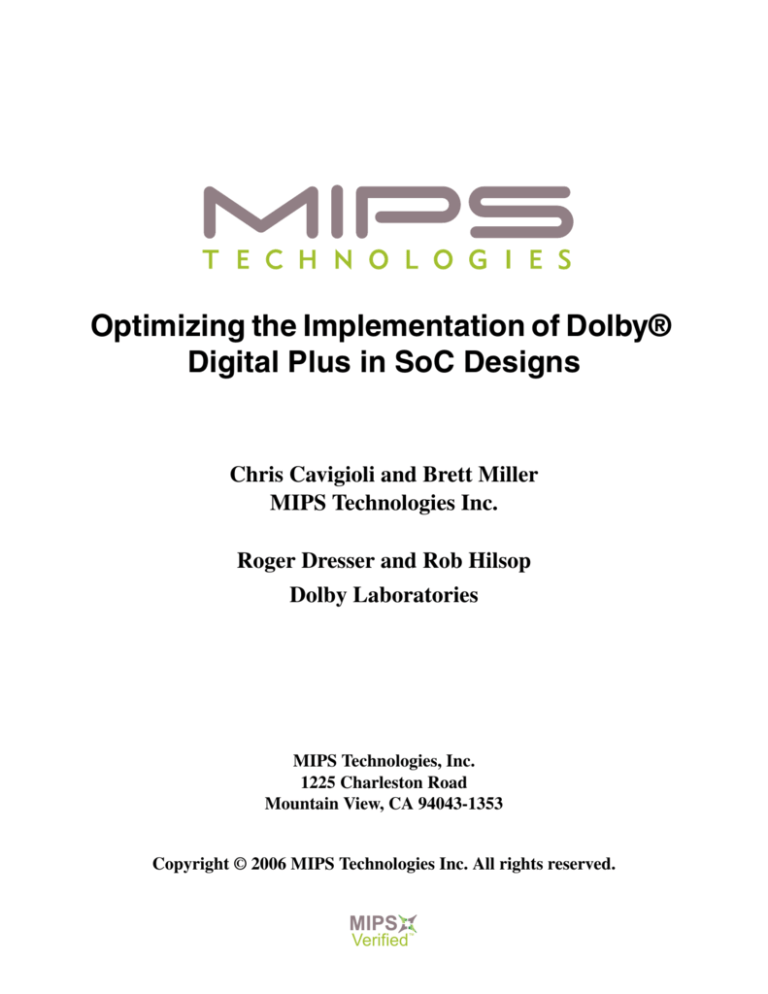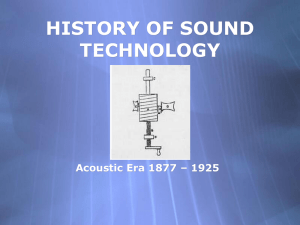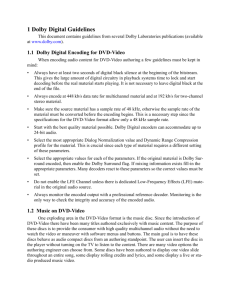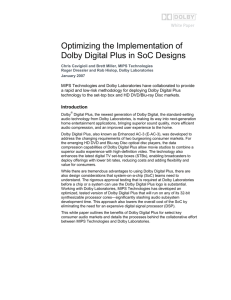
Optimizing the Implementation of Dolby®
Digital Plus in SoC Designs
Chris Cavigioli and Brett Miller
MIPS Technologies Inc.
Roger Dresser and Rob Hilsop
Dolby Laboratories
MIPS Technologies, Inc.
1225 Charleston Road
Mountain View, CA 94043-1353
Copyright © 2006 MIPS Technologies Inc. All rights reserved.
MIPS
Verified
™
MIPS Technologies and Dolby Laboratories have collaborated to provide a rapid and low-risk methodology for
deploying the latest Dolby Digital Plus technology to the set-top box and HD DVD/Blu-ray Disc™ markets.
1 Introduction
Dolby® Digital Plus, the newest generation of Dolby Digital, the standard-setting audio technology from Dolby Laboratories, is making its way into next-generation home entertainment applications, bringing superior sound quality,
more efficient audio compression, and an improved user experience to the home.
Dolby Digital Plus, also known as Enhanced AC-3 (E-AC-3), has been developed to address the changing requirements of two burgeoning consumer markets. For the emerging HD DVD and Blu-ray Disc™ optical disc players, the
data compression capabilities of Dolby Digital Plus allow movie studios to combine a superior audio experience with
high-definition video. The technology also enhances the latest digital TV set-top boxes (STBs), enabling broadcasters
to deploy offerings with lower bit rates, reducing costs and adding flexibility and value for consumers.
While there are tremendous advantages to using Dolby Digital Plus, there are also design considerations that systemon-a-chip (SoC) teams need to understand. The rigorous approval testing that is required at Dolby Laboratories
before a chip or a system can use the Dolby Digital Plus logo is substantial. Working with Dolby Laboratories, MIPS
Technologies has developed an optimized, tested version of Dolby Digital Plus that will run on any of its 32-bit synthesizable processor cores—significantly slashing audio subsystem development time. This approach also lowers the
overall cost of the SoC by eliminating the need for an expensive digital signal processor (DSP).
This white paper outlines the benefits of Dolby Digital Plus for select key consumer audio markets and details the
processes behind the collaborative effort between MIPS Technologies and Dolby Laboratories.
2 Emerging Standards for the Home Entertainment
Market
HD DVD and Blu-ray Disc
Dolby Digital Plus is mandatory in the HD DVD specification and is defined as optional in Blu-ray Disc. The specifications also allow for multiple independent streams so a movie can be shipped with multiple independent soundtracks
or support multiple languages.
For the first time, HD DVD and Blu-ray Disc players allow external streams from the Internet to be mixed with the
native audio on the disc after the disc has been shipped to the consumer. For example, a high-definition video stream
can be accompanied by an audio track mastered on the disc that is simultaneously mixed with a more recent director's
commentary streamed from a studio website.
Next-Generation Set-Top Boxes
Dolby Digital Plus is also vital to the next generation of set-top boxes. High-definition TV depends on high-quality
sound for a complete experience. Broadcasters and network operators are all looking at ways to dramatically improve
their offerings.
The greater compression of Dolby Digital Plus allows 5.1 surround sound using as few as 224 kbps, a significant
reduction from the current 384-448 kbps data rate typically used for Dolby Digital (AC-3). This provides an opportu-
Optimizing the Implementation of Dolby® Digital Plus in SoC Designs,
Copyright © 2006 MIPS Technologies Inc. All rights reserved.
2
2 Emerging Standards for the Home Entertainment Market
nity for broadcasters to enhance their services by allowing value-added services for the hearing or visually impaired.
For those broadcasters using MPEG stereo at 160-256 kbps, they can upgrade to 5.1-channel surround sound using
essentially the same bandwidth (see Figure 1).
Figure 1 Advantages of Upgrading to Dolby Digital Plus for Broadcasters
Dolby Digital Plus maintains backward compatibility with the worldwide installed base of more than 36 million
Dolby Digital audio/video receivers using an S/PDIF connection (Figure 2).
Fully decoding the stream to linear PCM and then re-encoding it to Dolby Digital would require significant processing power and would reduce the audio quality. Using an efficient low-latency, low-complexity conversion process,
Dolby Digital Plus streams are converted into Dolby Digital streams more easily and with less impact on audio quality.
3
Optimizing the Implementation of Dolby® Digital Plus in SoC Designs
Copyright © 2006 MIPS Technologies Inc. All rights reserved.
Figure 2 S/PDIF Connection from Set-top Box or Optical Disc Player to A/V Receiver today requires that a
Dolby Digital Plus Stream be converted to a 640 kbps Dolby Digital bitstream.
With the high-speed HDMITM interface becoming increasingly common on newer STBs, the Dolby Digital Plus
streams (either coded or uncoded) can be transmitted directly to a new generation of A/V receivers, resulting in audio
of a higher quality than ever before (Figure 3).
Figure 3 HDMI Connection on Set-top Box allows a full Dolby Digital Plus Stream to be transmitted directly.
3 Dolby Digital Plus Software Development
Some system developers use a dedicated audio DSP and adapt the audio code from the floating-point reference code
that is supplied by Dolby Laboratories. This approach can be arduous and expensive considering the cost of the extra
silicon, DSP royalties and board tests. Working with a different set of development tools for the DSP design in addition to the system design also increases the time it takes to develop the implementation. The end unit then has to be
extensively tested and approved by Dolby Laboratories to attain the Dolby Digital Plus logo.
Optimizing the Implementation of Dolby® Digital Plus in SoC Designs,
Copyright © 2006 MIPS Technologies Inc. All rights reserved.
4
4 Implementation
A lower cost, more flexible approach is to use a general-purpose processor core for the algorithms. The audio processing can be subsumed by the host CPU or moved to a second processor in a system chip, providing the Dolby Digital Plus capability at a nominal cost. Fewer components are needed, less board space and less power is used. Because
it is general purpose, the core can be used for other tasks in addition to decoding or converting the audio stream.
This approach requires a high-performance processor core and code that has been optimized specifically for that core
and approved by Dolby Laboratories. MIPS Technologies has worked closely with Dolby Laboratories on the implementation of the Dolby Digital Plus decoder. For designers or users of MIPS-Based™ SoCs, this significantly
reduces the risk, timescale and cost of adding Dolby Digital Plus to the end product.
4 Implementation
The Dolby Digital Plus reference software is written in floating-point C code and delivered to the licensee for implementation in a device or a DSP that is then sent to Dolby Laboratories for approval testing. Dolby Laboratories maintains a high standard of quality, so the testing procedure is correspondingly extensive.
To help ensure that the approval process goes smoothly, Dolby Laboratories provides two sets of tests to the implementer for use during development: a set of test vectors to rigorously exercise each part of the algorithm at a low
level and quickly compare the output of a decoder under test (DUT) with the output of a reference implementation,
and a more rigorous set of tests to verify the final implementation using Audio Precision® test equipment. The Audio
Precision tests essentially duplicate the testing Dolby Laboratories will perform. Passing both sets of tests in-house is
required prior to submission to reduce risk and makes it more likely that the implementation will pass at Dolby Laboratories.
As noted, MIPS Technologies has developed an optimized version of the code to streamline the process and to provide a high-quality implementation. This code, which has been approved by Dolby Laboratories, is provided to developers who have licensed both the Dolby Digital Plus technology and MIPS processor technology. While a MIPSBased SoC implementation still must go back to Dolby Laboratories for approval, using the pre-approved code significantly reduces risk for the implementer and helps ensure a quicker turnaround for approval at Dolby Laboratories
(Figure 4).
5
Optimizing the Implementation of Dolby® Digital Plus in SoC Designs
Copyright © 2006 MIPS Technologies Inc. All rights reserved.
Figure 4 Using MIPS-optimized code can cut months from the development time and approval process for
Dolby Digital Plus system chips and equipment.
Dolby Laboratories benefits in several ways, as most of the STB and optical disc SoCs are based on industry-standard
MIPS processor cores.
Using the MIPS-optimized version of the code can shave months from the development time of a typical project and
accelerate the approval cycle. In a similar fashion, MIPS Technologies also offers optimized and approval-tested
code for Dolby Digital (AC-3), Dolby Pro Logic® II, and other popular audio algorithms such as MPEG-2, AAC,
MP3, and SRS TruSurround XT®.
5 Optimizing for MIPS32® Implementation
In embedded systems, the most efficient implementation of an audio algorithm uses fixed-point arithmetic rather than
floating-point arithmetic. Therefore, one of the first steps in optimizing the Dolby reference implementation is to convert the floating-point reference code.
A high-quality conversion requires choosing a fixed-point representation (or potentially multiple representations at
different processing stages) that finds an optimal balance of dynamic range and precision. This allows the algorithm
to handle any potential input without exceeding the dynamic range of its representation while still providing sufficient precision. Just as important, choosing the optimal representation avoids the need for saturation checks after each
operation, significantly improving run-time performance.
MIPS Technologies accomplishes this conversion process using an extensive simulation and testing procedure,
ensuring that the implementation will meet the stringent audio-quality standards established by Dolby Laboratories.
An abstract C++ fixed-point class tracks the required dynamic range and precision of data throughout the algorithmic
processing. At the end of the simulation process, fixed-point representations and operations are chosen and hardwired
back into a pure C implementation.
Optimizing the Implementation of Dolby® Digital Plus in SoC Designs,
Copyright © 2006 MIPS Technologies Inc. All rights reserved.
6
6 Soft Audio Interface Integration
When choosing fixed-point representations, MIPS takes full advantage of its architecture. By carefully choosing representations, the 32-bit general-purpose registers (GPRs) of the MIPS32 architecture allow for a similar capability as
a DSP accumulator with guard bits, even with GPR-to-GPR operations. In some cases, where 32 bits is still insufficient, the HI/LO register pair of the accumulator can be used as a 64-bit accumulator to provide extra precision or
dynamic range as needed.
Converting the source code to fixed point is already one form of optimization. And given the fixed-point C source
code, the MIPS Software Development Environment (SDE) compiler tool chain is capable of producing highly efficient code, scheduled for a specific MIPS core pipeline without additional effort. However, some of the fixed-point
operations and critical DSP routines, such as IMDCT (inverse modified discrete cosine transform) and window overlap/add, can further benefit from architecture-specific optimizations that the compiler alone is not capable of generating. Such optimizations require a detailed understanding of both the MIPS architecture and the structure of the DSP
routines employed in Dolby Digital Plus.
6 Soft Audio Interface Integration
After producing a fully optimized fixed-point implementation of the Dolby Digital Plus code, MIPS encapsulates the
decoder-converter with its Soft Audio Interface (SAI), a standard API
supported by all MIPS-optimized audio codecs. The SAI abstracts many of the complexities of particular algorithms
and allows developers to think of them in terms of components that can be readily added or removed from an application. By standardizing the way in which the MIPS Soft Audio algorithms are used, the SAI also facilitates the reuse of
application-level code for different or changing audio processing tasks, and makes it easy to cascade multiple audio
codecs using shared intermediate memory buffers (Figure 5).
7
Optimizing the Implementation of Dolby® Digital Plus in SoC Designs
Copyright © 2006 MIPS Technologies Inc. All rights reserved.
Figure 5 The flow for converting floating-point Dolby code to highly optimized fixed-point MIPS32 code.
All this allows the system designer significant flexibility. The codec can be run on the main system CPU or on a second core used as an audio co-processor. The size of the core and its supporting memory is an issue for the system
architect. Using a general-purpose MIPS core means it can be used for a wide range of other functions as well as
Dolby Digital Plus and other audio codecs.
This approach also allows the system design to be scalable. A small low-cost, entry-level 4KETM core can be used
for a low-bandwidth implementation of Dolby Digital Plus, while the latest multi-threaded 34KTM core could be
used for a high-definition implementation and a host controller (Figure 6). The multi-threading allows the 34K core
to behave as two virtual processors within the single core by optimizing the use of the instruction pipeline and the
memory to fully maximize the hardware. The two processors look independent to the main system, so one can handle
the host operating system while the other handles the audio and video subsystems.
Finally, there is a distinct advantage to the developer designing a multi-core system (a host processor and audio
coprocessor, for example) to utilize a common development environment. Using the same set of development tools
makes it easier for teams to work together, to debug the system, and also simplifies load balancing.
Optimizing the Implementation of Dolby® Digital Plus in SoC Designs,
Copyright © 2006 MIPS Technologies Inc. All rights reserved.
8
7 Conclusion
Figure 6 The tested, optimized Dolby Digital Plus code can be used across the entire array of MIPS cores.
7 Conclusion
Dolby Digital Plus is a new audio coding technology that represents significant value to broadcasters in the STB market and is specified as a standard audio format for the high-definition video disc markets. Dolby Digital Plus saves 33
percent bandwidth for broadcasters, giving them lower transmission costs or the ability to deploy value-added services on the unused bandwidth. For broadcasters using MPEG stereo, they can now transmit 5.1-channel surround
sound in virtually the same bandwidth using Dolby Digital Plus. In the blue-laser optical disc market, Dolby Digital
Plus is mandatory for HD DVD and optional for Blu-ray Disc.
MIPS is the #1 architecture in the STB, DTV and DVD recorder markets today. In order to facilitate the rapid deployment of Dolby Digital Plus across the variety of MIPS-Based SoCs in those markets, MIPS Technologies has
licensed the Dolby Digital Plus technology and already completed the tedious task of optimizing it in fixed point for
the whole family of MIPS processors. Now, SoC designers have a shortcut to get to market with less risk. They get
the reference code from Dolby Laboratories, but they can confidently use the code from MIPS Technologies that has
already been optimized for the MIPS architecture and has already been tested and approved by Dolby Laboratories.
Final SoCs are more likely to pass Dolby Laboratories approval testing quickly.
With the cooperation between MIPS Technologies and Dolby Laboratories, the industry benefits by saving development costs and reducing risk, bringing Dolby Digital Plus, and its benefits, to the retail consumer faster.
9
Optimizing the Implementation of Dolby® Digital Plus in SoC Designs
Copyright © 2006 MIPS Technologies Inc. All rights reserved.
Copyright © 2006 MIPS Technologies, Inc. All rights reserved.
Unpublished rights (if any) reserved under the copyright laws of the United States of America and other countries.
This document contains information that is proprietary to MIPS Technologies, Inc. ("MIPS Technologies"). Any copying, reproducing, modifying or use of
this information (in whole or in part) that is not expressly permitted in writing by MIPS Technologies or an authorized third party is strictly prohibited. At a
minimum, this information is protected under unfair competition and copyright laws. Violations thereof may result in criminal penalties and fines.
Any document provided in source format (i.e., in a modifiable form such as in FrameMaker or Microsoft Word format) is subject to use and distribution
restrictions that are independent of and supplemental to any and all confidentiality restrictions. UNDER NO CIRCUMSTANCES MAY A DOCUMENT
PROVIDED IN SOURCE FORMAT BE DISTRIBUTED TO A THIRD PARTY IN SOURCE FORMAT WITHOUT THE EXPRESS WRITTEN
PERMISSION OF MIPS TECHNOLOGIES, INC.
MIPS Technologies reserves the right to change the information contained in this document to improve function, design or otherwise. MIPS Technologies does
not assume any liability arising out of the application or use of this information, or of any error or omission in such information. Any warranties, whether
express, statutory, implied or otherwise, including but not limited to the implied warranties of merchantability or fitness for a particular purpose, are excluded.
Except as expressly provided in any written license agreement from MIPS Technologies or an authorized third party, the furnishing of this document does not
give recipient any license to any intellectual property rights, including any patent rights, that cover the information in this document.
The information contained in this document shall not be exported, reexported, transferred, or released, directly or indirectly, in violation of the law of any
country or international law, regulation, treaty, Executive Order, statute, amendments or supplements thereto. Should a conflict arise regarding the export,
reexport, transfer, or release of the information contained in this document, the laws of the United States of America shall be the governing law.
The information contained in this document constitutes one or more of the following: commercial computer software, commercial computer software
documentation or other commercial items. If the user of this information, or any related documentation of any kind, including related technical data or manuals,
is an agency, department, or other entity of the United States government ("Government"), the use, duplication, reproduction, release, modification, disclosure,
or transfer of this information, or any related documentation of any kind, is restricted in accordance with Federal Acquisition Regulation 12.212 for civilian
agencies and Defense Federal Acquisition Regulation Supplement 227.7202 for military agencies. The use of this information by the Government is further
restricted in accordance with the terms of the license agreement(s) and/or applicable contract terms and conditions covering this information from MIPS
Technologies or an authorized third party.
MIPS, MIPS I, MIPS II, MIPS III, MIPS IV, MIPS V, MIPS-3D, MIPS16, MIPS16e, MIPS32, MIPS64, MIPS-Based, MIPSsim, MIPSpro, MIPS Technologies
logo, MIPS-VERIFIED, MIPS-VERIFIED logo, 4K, 4Kc, 4Km, 4Kp, 4KE, 4KEc, 4KEm, 4KEp, 4KS, 4KSc, 4KSd, M4K, 5K, 5Kc, 5Kf, 24K, 24Kc, 24Kf,
24KE, 24KEc, 24KEf, 34K, 34Kc, 34Kf, 74K, 74Kf, 74Kc, 1004K, 1004Kc, 1004Kf, R3000, R4000, R5000, ASMACRO, Atlas, "At the core of the user
experience.", BusBridge, Bus Navigator, CLAM, CorExtend, CoreFPGA, CoreLV, EC, FPGA View, FS2, FS2 FIRST SILICON SOLUTIONS logo, FS2
NAVIGATOR, HyperDebug, HyperJTAG, JALGO, Logic Navigator, Malta, MDMX, MED, MGB, OCI, PDtrace, the Pipeline, Pro Series, SEAD, SEAD-2,
SmartMIPS, SOC-it, System Navigator, and YAMON are trademarks or registered trademarks of MIPS Technologies, Inc. in the United States and other
countries.
All other trademarks referred to herein are the property of their respective owners.
Copyright © 2006 MIPS Technologies Inc. All rights reserved.







